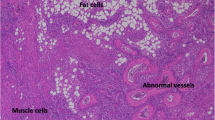Abstract
Purpose
The main purpose of this study is to explore characteristics of patients with chronic kidney disease in tuberous sclerosis (TSC) and to underline differences in clinical characteristics between end-stage renal disease (ESRD) patients and patients in earlier stages of chronic kidney disease.
Methods
This multicentric, retrospective study included data for 48 patients from seven South-Eastern European countries (Albania, Bosnia and Herzegovina, Croatia, Greece, Montenegro, Serbia, Slovenia) in the period from February to August 2020. Researchers collected data from local and national nephrological and neurological registries and offered clinical and laboratory results from medical histories in follow-up periods.
Results
This study enrolled 48 patients with a median age of 32.3 years (range, 18–46 years), and predominant female gender (60.45%). The percentage of patients with chronic kidney disease (CKD) diagnosis of the total number of patients was 66.90%, with end-stage renal disease development in 39.6%. The most prevalent renal lesions leading to chronic kidney disease were angiomyolipomas (AMLs) in 76.6%, while multiple renal cysts were present in 42.6% of patients. Nephrectomy was performed in 43% of patients, while the mTOR inhibitors were used in 18 patients (37.5%). The majority of patients had cutaneous manifestations of tuberous sclerosis—83.30% had hypomelanotic cutaneous lesions, and 68.80% had angiofibromas. Multiple retinal nodular hamartomas and "confetti" skin lesions were more frequent in end-stage renal disease (ESRD) than in patients with earlier stages of chronic kidney disease (p-0.033 and 0.03, respectively).
Conclusion
Our study has also shown that retinal hamartomas and "confetti" skin lesions are more frequent in end-stage renal diseases (ESRD) patients than in other chronic kidney disease (CKD) patients. Usage of mTOR inhibitors can also reduce the number of complications and associated with tuberous sclerosis, such as dermatological manifestations and retinal hamartoma, which are more common in the terminal stage of chronic kidney disease.

Similar content being viewed by others
References
Chu WCY, Chiang LLW, Chan DCC et al (2020) Prevalence, mortality and healthcare economic burden of tuberous sclerosis in Hong Kong: a population-based retrospective cohort study (1995–2018). Orphanet J Rare Dis 15:264. https://doi.org/10.1186/s13023-020-01517-2
Marom D (2020) Genetics of tuberous sclerosis complex: an update. Childs Nerv Syst 36:2489–2496. https://doi.org/10.1007/s00381-020-04726-z
Trnka P, Kennedy SE (2021) Renal tumors in tuberous sclerosis complex. Pediatr Nephrol 36:1427–1438. https://doi.org/10.1007/s00467-020-04775-1
Bissler JJ et al (2019) Effect of everolimus on renal function. Nephrol Dial Transplant 34:1000–1008. https://doi.org/10.1093/ndt/gfy132
Krueger DA, Northrup H, International Tuberous Sclerosis Complex Consensus Group (2013) Tuberous sclerosis complex surveillance and management: recommendations of the 2012 International Tuberous Sclerosis Complex Consensus Conference. Pediatr Neurol 49:255–265
Ahn H, Yum M-S, Jang HN, Song C, Ko T-S et al (2019) Experience of a single center in treating multiple manifestations of tuberous sclerosis complex with everolimus. Ann Child Neurol 27(4):135–145
Zhang C, Xu K, Long Q et al (2020) Clinical features and optical coherence tomography findings of retinal astrocytic hamartomas in Chinese patients with tuberous sclerosis complex. Graefes Arch Clin Exp Ophthalmol 258:887–892. https://doi.org/10.1007/s00417-019-04476-y
Nguyen QB, DarConte M, Hebert AA (2018) The cutaneous manifestations of tuberous sclerosis complex. Am J Med Genet 178(3):321–325
Vabret E et al (2021) From tuberous sclerosis complex to end stage renal disease: who are these patients? J Nephrol 34(2):607–615. https://doi.org/10.1007/s40620-020-00714-3 (Epub 2020 Mar 4)
Zöllner JP et al (2020) A systematic review on the burden of illness in individuals with tuberous sclerosis complex (TSC). Orphanet J Rare Dis 15:23. https://doi.org/10.1186/s13023-019-1258-3
Kingswood JC et al (2017) TuberOus SClerosis registry to increase disease Awareness (TOSCA) – baseline data on 2093 patients. Orphanet J Rare Dis 12:2. https://doi.org/10.1186/s13023-016-0553-5
Budde K, Gaedeke J (2012) Tuberous sclerosis complex-associated angiomyolipomas: focus on mTOR inhibition. Am J Kidney Dis 59(2):276–283
Adriaensen ME, Schaefer-Prokop CM, Duyndam DA, Zonnenberg BA, Prokop M (2011) Radiological evidence of lymphangioleiomyomatosis in female and male patients with tuberous sclerosis complex. Clin Radiol 66(7):625–628
Caban C, Khan N, Hasbani DM, Crino PB (2017) Genetics of tuberous sclerosis complex: implications for clinical practice. Appl Clin Genet 10:1–8
Yamakado K, Tanaka N, Nakagawa T et al (2002) Renal angiomyolipoma: relationships between tumor size, aneurysm formation, and rupture. Radiology 225:78–82
Bissler JJ et al (2019) Effect of everolimus on renal function in patients with tuberous sclerosis complex: evidence from EXIST-1 and EXIST-2. Nephrol Dial Transplant 34:1000–1008. https://doi.org/10.1093/ndt/gfy132
Herscu K et al (2019) Retinal hamartomas respond to everolimus treatment for tuberous sclerosis: a photo essay. Clin Exp Vision Eye Res 2:52–54
Funding
This study was not funded by grant.
Author information
Authors and Affiliations
Corresponding author
Ethics declarations
Conflict of interest
All authors declare that they have no conflict of interests.
Ethical approval
All procedures performed in studies involving human participants were in accordance with the ethical standards of the institutional and/or national research committee and with the 1964 Helsinki declaration and its later amendments or comparable ethical standards.
Informed consent
Informed consent was obtained from all individual participants included in the study.
Additional information
Publisher's Note
Springer Nature remains neutral with regard to jurisdictional claims in published maps and institutional affiliations.
Rights and permissions
Springer Nature or its licensor holds exclusive rights to this article under a publishing agreement with the author(s) or other rightsholder(s); author self-archiving of the accepted manuscript version of this article is solely governed by the terms of such publishing agreement and applicable law.
About this article
Cite this article
Prelevic, V., Juric, I., Bevc, S. et al. Association of multiple retinal nodular hamartomas and "confetti" skin lesions with end-stage renal disease in patients with tuberous sclerosis. Int Urol Nephrol 55, 477–482 (2023). https://doi.org/10.1007/s11255-022-03352-9
Received:
Accepted:
Published:
Issue Date:
DOI: https://doi.org/10.1007/s11255-022-03352-9




